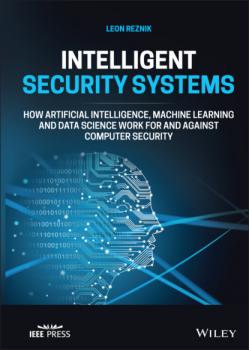John Wiley & Sons Limited
Все книги издательства John Wiley & Sons LimitedEEG Signal Processing and Machine Learning
Explore cutting edge techniques at the forefront of electroencephalogram research and artificial intelligence from leading voices in the field The newly revised Second Edition of EEG Signal Processing and Machine Learning delivers an inclusive and thorough exploration of new techniques and outcomes in electroencephalogram (EEG) research in the areas of analysis, processing, and decision making about a variety of brain states, abnormalities, and disorders using advanced signal processing and machine learning techniques. The book content is substantially increased upon that of the first edition and, while it retains what made the first edition so popular, is composed of more than 50% new material. The distinguished authors have included new material on tensors for EEG analysis and sensor fusion, as well as new chapters on mental fatigue, sleep, seizure, neurodevelopmental diseases, BCI, and psychiatric abnormalities. In addition to including a comprehensive chapter on machine learning, machine learning applications have been added to almost all the chapters. Moreover, multimodal brain screening, such as EEG-fMRI, and brain connectivity have been included as two new chapters in this new edition. Readers will also benefit from the inclusion of: A thorough introduction to EEGs, including neural activities, action potentials, EEG generation, brain rhythms, and EEG recording and measurement An exploration of brain waves, including their generation, recording, and instrumentation, including abnormal EEG patterns and the effects of ageing and mental disorders A treatment of mathematical models for normal and abnormal EEGs Discussions of the fundamentals of EEG signal processing, including statistical properties, linear and nonlinear systems, frequency domain approaches, tensor factorization, diffusion adaptive filtering, deep neural networks, and complex-valued signal processing Perfect for biomedical engineers, neuroscientists, neurophysiologists, psychiatrists, engineers, and students and researchers in the above areas, the Second Edition of EEG Signal Processing and Machine Learning will also earn a place in the libraries of undergraduate and postgraduate Biomedical Engineering and Neuroscience, including Epileptology, students.
Astrobiology
ASTROBIOLOGY[/b] This unique book advances the frontier discussion of a wide spectrum of astrobiological issues on scientific advances, space ethics, social impact, religious meaning, and public policy formulation. Astrobiology is an exploding discipline in which not only the natural sciences, but also the social sciences and humanities converge. Astrobiology: Science, Ethics, and Public Policy is a multidisciplinary book that presents different perspectives and points of view by its contributing specialists. Epistemological, moral and political issues arising from astrobiology, convey the complexity of challenges posed by the search for life elsewhere in the universe. We ask: if a convoy of colonists from Earth make the trip to Mars, should their genomes be edited to adapt to the Red Planet’s environment? If scientists discover a biosphere with microbial life within our solar system, will it possess intrinsic value or merely utilitarian value? If astronomers discover an intelligent civilization on an exoplanet elsewhere in the Milky Way, what would be humanity’s moral responsibility: to protect Earth from an existential threat? To treat other intelligences with dignity? To exploit through interstellar commerce? To conquer? Audience The book will attract readers from a wide range of interests including astronomers, astrobiologists, chemists, biologists, space engineers, ethicists, theologians and philosophers.
My Secret Brexit Diary
In June 2016, the people of the United Kingdom voted to leave the European Union. As the EU’s chief negotiator, for four years Michel Barnier had a seat at the table as the two sides thrashed out what ‘Brexit’ would really mean. The result would change Britain and Europe forever. During the 1600 days of complex and often acrimonious negotiations, Michel Barnier kept a secret diary. He recorded his private hopes and fears, and gave a blow-by-blow account as the negotiations oscillated between consensus and disagreement, transparency and lies. From Brussels to London, from Dublin to Nicosia, Michel Barnier’s secret diary lifts the lid on what really happened behind the scenes of one of the most high-stakes negotiations in modern history. The result is a unique testimony from the ultimate insider on the hidden world of Brexit and those who made it happen.
Management of Radioactive Waste
The classification of radioactive waste varies from state to state. This results in different management procedures for each country, while following IAEA and OECD/NEA recommendations.<br /><br />Radioactive waste comes from numerous sources. The largest volumes are generated by the decommissioning and dismantling of nuclear facilities. Long-lived, medium- and high-activity waste – categorized as the most hazardous types of waste – are in fact largely produced by nuclear power reactors, spent fuel reprocessing plants and nuclear accidents.<br /><br />Final disposal of very low-activity, low-activity and very short-lived waste is well controlled. However, final solutions for certain categories, including long-lived waste, sorted waste and spent graphite waste, are not yet in place.<br /><br /><i>Management of Radioactive Waste</i> reviews all the possible solutions and presents those chosen by the various states, including a chapter detailing policy on radioactive waste management, taking France as an example.
The Contributory Revolution
This book sheds light on a crucial debate on the possible role of the technosciences in meeting the challenges of the future. It shows that the current contributory revolution is global and profound, and that it concerns the whole epistemological field – from the sciences to social organizations. By delving into the epistemological dimension of the lightning transition we are currently experiencing, The Contributory Revolution identifies the levers of the salutary acceleration of collective learning, now essential, but not before the debate on a possible future has been settled via the headlong rush of the technoscientist.<br /><br />However, after this call to move from exo-distributive technoscience, carried by deterministic and Newtonian models, to more biological and endocontributory models – or even from the arrogance of mastery to the humility of influence and alliance – it will be necessary to set its limits to avoid entering into an eco-philosophical radicalism. Only extreme humility, carried by strong spirituality, can protect us from it.









